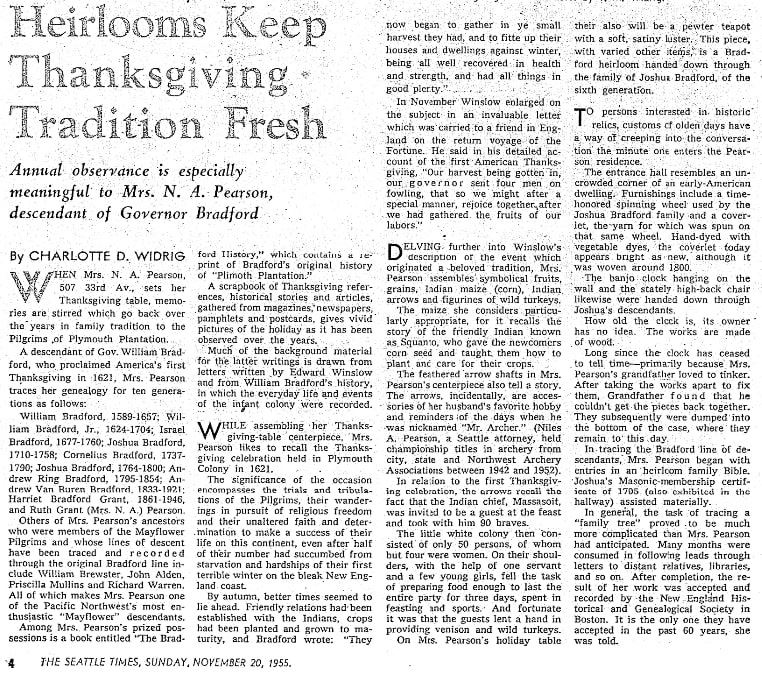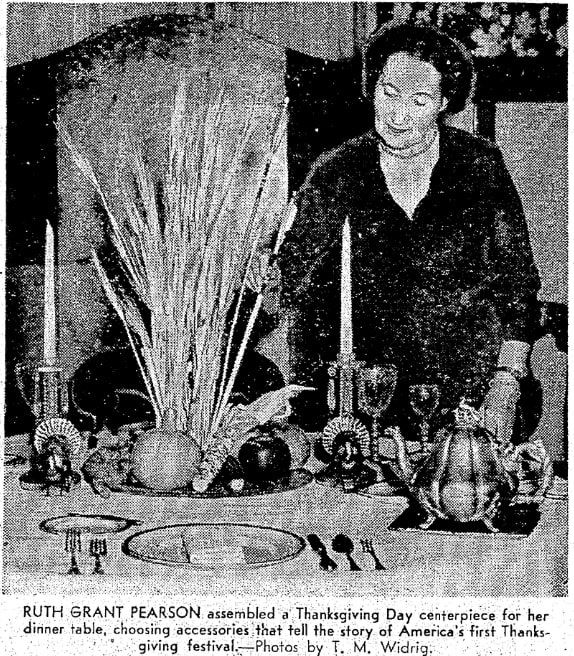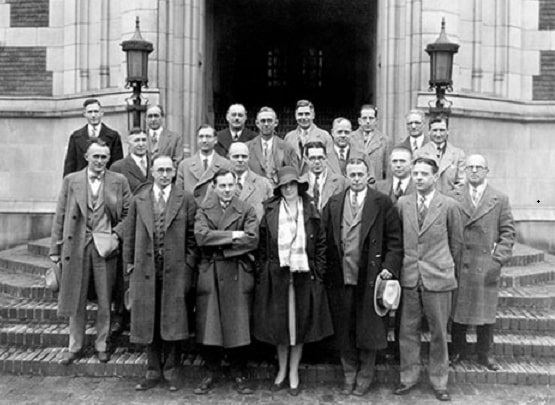Introduction: In this article, Melissa Davenport Berry writes about the family heirlooms and Thanksgiving display of Mayflower descendant Ruth Grant Pearson. Melissa is a genealogist who has a blog, AnceStory Archives, and a Facebook group, New England Family Genealogy and History.
Ruth Grant Pearson’s annual Thanksgiving spread was featured in the Seattle Daily Times in 1955 by reporter Charlotte D. Widrig. Ruth, “one of the Pacific Northwest’s most enthusiastic ‘Mayflower’ descendants” was a proud member of the Washington State Society of Mayflower Descendants and celebrated her holiday in the fashion of Plymouth Colony in 1621.

Ruth showed many of her prized possessions to Widgrig. One was a copy of Plimoth Plantation, written by her 9th great grandaddy Governor William Bradford.
Ruth’s family line: William Bradford (1598-1657); William Jr. (1645-1704); Israel (1677-1760); Joshua (1710-1790); Cornelius (1737-1790); Joshua (1764-1800); Andrew Ring (1795-1854); Andrew Von Buren (1833-1921); and her mother Harriet “Hattie” Shackford Bradford (1861-1946), who married Dr. John Phillip Grant. Ruth’s line also married into the Mayflower lines of William Brewster, John Alden, Priscilla Mullens, and Richard Warren.
Ruth said that it was no easy task tracing her Bradford line, but a family heirloom Bible provided a map to work from. In this treasure trove is a record of Joshua Bradford’s Masonic membership in 1795.
In her article, Widrig wrote:
“In general, the task of tracing a ‘family tree’ proved to be much more complicated than Mrs. Pearson had anticipated. Many months were consumed in following leads through letters to distant relatives, libraries, and so on. After completion, the result of her work was accepted and recorded by the New England Historic Genealogical Society in Boston. It is the only one they have accepted in the past 60 years, she was told.”
Widrig also wrote:
“The significance of the occasion [Thanksgiving] encompasses the trials and tribulations of the Pilgrims, their wanderings in pursuit of religious freedom and their unaltered faith and determination to create a success of their life on this continent, even after half of their number had succumbed from starvation and hardships of their first terrible winter on the bleak New England coast.”
As Bradford recorded:
“They now began to gather in ye small harvest they had, and to fitte up their houses and dwellings against winter, being all well recovered in health and strength, all had all things in good plenty.”
Another testament that survived to tell of the first Thanksgiving was a letter by Mayflower passenger Edward Winslow written to a friend on 11 December 1621 and carried across the Atlantic to England on the ship Fortune. You can read the full letter on Caleb Johnson’s MayflowerHistory.com.
Winslow wrote:
“Our harvest being gotten in, our governor sent four men on fowling, that so we might after a special manner, rejoice together after we had gathered the fruits of our labors.”

Ruth’s table accessories were inspired by the words of Winslow. A centerpiece decorated with symbolic fruits, grains, Indian maize (corn), feathers, arrows, and figurines of wild turkeys. A pewter teapot is also displayed; it belonged to Joshua Bradford of the sixth generation.
The arrows had special meaning for Ruth. Her husband Miles held championship titles in archery from Northwest Archery Associations, which earned him the nickname “Mr. Archer.”

Secondly, the arrows represented Indian Chief Massasoit, leader of the Wampanoag, the honored guest who attended the first Thanksgiving, as described in Winslow’s letter:
“…their greatest King Massasoit, with some ninety men, whom for three days we entertained and feasted, and they went out and killed five deer, which they brought to the plantation.” According to Johnson, “Massasoit lived a long life and remained a close friend and ally of the Plymouth Colony until his death around 1661.”

Widrig also wrote about the significant pieces displayed in Ruth’s entrance hall:
“The entrance hall resembles an uncrowded corner of an early-American dwelling. Furnishings include a time-honored spinning wheel used by the Joshua Bradford family and a coverlet, the yarn for which was spun on that same wheel. Hand-dyed with vegetable dyes, the coverlet today appears bright as new, although it was woven around 1800.”
Ruth compiled over 50 scrapbooks on her family and history which were donated. She claimed membership to the Rainier Chapter of the Daughters of the American Revolution via her Cornelius Bradford, who commanded the 6th regiment of Col. Mason Wheaton’s regiment of Lincoln County, Massachusetts, militia.

Ruth also earned a BA from the University of Washington, College of Economics and Business Administration (1926) and became one of its first female faculty members. She was head of the merchandising curriculum from 1926-31 and established the University Women’s Vocational Club in 1928, named “outstanding project of the year” by Dean William Cox.

Recently found out I was descended from Stephen Hopkins from the Mayflower. Have started doing research. Would love more information.
Always enjoy everything you put out!
Sydney Biddle Barrows
Descendant of William Brewster
Sydney, thank you so much! It has been a pleasure working with you and exploring your heritage. So many good finds on the GenealogyBank site for your Mayflower ties. Warmest Holiday Wishes!